|
Nov. 3, 1909 - Lieut. George Sweet was taken up as a passenger in the first Army Wright aircraft by Lieut. Frank P. Lahm, USA, at College Park, Md. Lieut. Sweet is credited with being the first Navy officer to have flown in an airplane. |

|
Sept. 26, 1910 - The Secretary of the Navy, George von L. Meyer, designated Capt. Washington I. Chambers, Assistant to the Aid for Material, as the officer to whom all correspondence on aviation should be referred. This is the first recorded reference to a provision for aviation in the Navy Department. |
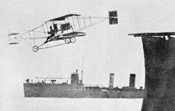 |
Nov. 14, 1910 - Eugene Ely, 24, a civilian pilot, took off in a 50-hp. Curtiss plane from a wooden platform built over the bow of the light cruiser USS Birmingham (CL-2). The ship was at anchor in Hampton Roads, Va., and Ely landed moments later on Willoughby Spit. |
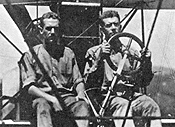
|
Nov. 29, 1910 - Glenn H. Curtiss wrote to Secretary Meyer offering flight instruction without charge for one Navy officer as one means of assisting "in developing the adaptability of the aeroplane to military purposes." On Dec. 23, Lieut. T. Gordon "Spuds" Ellyson, left in picture, was ordered to report to the Glenn Curtiss Aviation Camp at North Island, San Diego, Calif. He completed his training Apr. 12, 1911, and became Naval Aviator No. 1. |
 |
Jan. 18, 1911 - At 11:01 a.m., Eugene Ely, flying a Curtiss pusher, landed on a specially built platform aboard the armored cruiser USS Pennsylvania (ACR 4) at anchor in San Francisco Bay. At 11:58 a.m., he took off and returned to Selfridge Field, San Francisco. |
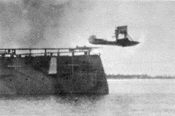 |
Nov. 5, 1915 - Lieut. Cmdr. Henry C. Mustin made the first catapault launching from a ship. He flew an AB-2 flying boat off the stern of USS North Carolina (ACR 12) in Pensacola Bay, Fla. |

|
Jul. 11, 1919 - The Naval Appropriations Act for Fiscal Year 1920 provided for the conversion of the collier Jupiter into a ship specifically designed to launch and recover airplanes at sea — an aircraft carrier — later to be named Langley. The engineering plans for this conversion were modified in November and included catapults to be fitted on both the forward and after ends of the "flying-off" deck. |

|
Mar. 20, 1922 - USS Langley (CV 1), converted from the collier USS Jupiter (AC 3), was placed in commission at Norfolk, Va., as the Navy's first aircraft carrier. The ship's executive officer, Cmdr. Kenneth Whiting, was in command. |
|
Apr. 1, 1922 - The specifications of arresting gear of the type later installed in early aircraft carriers were sent to various design engineers. "The arresting gear will consist of two or more transverse wires stretched across the fore and aft wires ... [and which] lead around sheaves placed outboard to hydraulic brakes. The plane, after engaging the transverse wire, is guided down the deck by the fore and aft wires and is brought to rest by the action of the transverse wire working with the hydraulic brake." |
|
Jul. 1, 1922 - Congress authorized the conversion of the unfinished battle cruisers Lexington and Saratoga as aircraft carriers and as permitted under the terms of the Washington Treaty. |
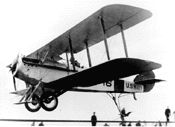
|
Oct. 17, 1922 - Lieut. V.C. Griffin, in a Vought VE-7SF, like the one to the left, took off from USS Langley at anchor in the York River, Virginia, making the first take-off from an aircraft carrier. |

|
Oct. 26, 1922 - Lieut. Cmdr. Godfrey deC. Chevalier, flying an Aeromarine, made the first landing aboard USS Langley underway off Cape Henry, Virginia. Lieut. Cmdr. Chevalier, Naval Aviator #7, died Nov. 14 in the Naval Hospital, Portsmouth, Va., of injuries suffered in a plane crash two days earlier at Lochaven, near Norfolk. |
|
Nov. 18, 1922 - Cmdr. Kenneth Whiting, piloting a PT seaplane, made the first catapult launching from USS Langley (CV 1) at anchor in the York River. |

|
Nov. 17, 1924 - Langley reported for duty with the Battle Fleet, thereby ending two years in an experimental status and becoming the first operational aircraft carrier in the U.S. Navy. On 1 Dec., she also became the flagship for Aircraft Squadrons, Battle Fleet. |
 |
Nov. 16, 1927 - USS Saratoga (CV 3) commissioned at Camden, N.J., Capt. Harry E. Yarnell, commanding. |

|
Dec. 14, 1927 - USS Lexington (CV 2) commissioned at Quincy, Mass., Capt. Albert W. Marshall, commanding. |
|
Jan. 11, 1928 - The first take off and landing aboard USS Saratoga (CV 3) was made by the ship's Air Officer Cmdr. Marc A. Mitscher in a UO-1. |
|
Jan. 23-27, 1929 - The carriers Lexington and Saratoga took part in fleet exercises, attached to opposing forces. Saratoga was detached from the main force, and with an escorting cruiser, was sent on a wide southward sweep before turning north to approach within striking distance of her target, the Panama Canal. On the morning of the 26th, while it was still dark, she launched a strike group of 69 aircraft which arrived over the target undetected shortly after dawn and completed the theoretical destruction of the Miraflores and Pedro Miguel locks without opposition. This demonstration made a profound impression on naval tacticians. |
|
Apr. 9, 1929 - Operations aboard Langley and Saratoga confirmed that the fore-and-aft wires of the arresting gear were not needed. The Secretary of the Navy authorized their removal in September. All carrier aircraft, based on these tests, were equipped with brakes and wheel type tail skids. |
|
Jan. 16, 1930 - USS Lexington (CV 2) completed a 30-day period in which she furnished electricity to the city of Tacoma, Wash., in an emergency arising from a failure of the city's power supply. The electricity from the carrier totaled more than 4.25 million kilowatt-hours. |

|
Sept. 26, 1931 - The keel for USS Ranger (CV 4), the first ship of the U.S. Navy to be designed and constructed as an aircraft carrier, was laid at the Newport News Shipbuilding and Drydock Company in Newport News, Va. The ship was launched on 25 Feb. 1933, and commissioned 4 Jun. 1934 at the Norfolk Navy Yard, Capt. Arthur L. Bristol, commanding. |
|
Nov. 1, 1934 - The Naval Aircraft Factory was authorized to manufacture and test a flush-deck hydraulic catapult, Type H Mark I. This catapult was designed to launch land planes from aircraft carriers and was the Navy's initial development of a hydraulic catapult, a type which was to be the primary means of launching land planes from carriers. |

|
Apr. 21, 1937 - Following a four-month conversion period, the Navy's first carrier USS Langley was converted to a seaplane tender and reclassified as AV-3. |
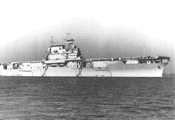
|
Sept. 30, 1937 - USS Yorktown (CV 5) was placed in commission at the Norfolk Naval Operating Base (NOB), Norfolk, Va., with Capt. Ernest D. McWhorter in command. The ship's keel was laid on 21 May 1934 and it was launched on 4 April 1936. |

|
May 12, 1938 - USS Enterprise (CV 6) was placed in commission at the Newport News Shipbuilding and Drydock Company, Newport News, Va., Capt. N. H. White commanding. The ship was launched 3 Oct. 1936. |
|
Jun. 11-13, 1939 - USS Saratoga (CV 3) and the tanker USS Kanawha (AO 1) conducted underway refueling tests off the coast of southern California, demonstrating the feasibility of refueling carriers at sea. |
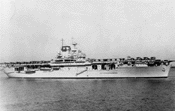
|
Apr. 25, 1940 - USS Wasp (CV 7) was placed in commission at the Army Quartermaster Base, Boston, Mass., Capt. John W. Reeves, Jr., commanding. The ship's keel was laid 1 Apr. 1936, at Quincy, Mass., by the Bethlehem Shipbuilding Co., and the ship was launched 4 Apr. 1939. |

|
Jun. 2, 1941 - USS Long Island (AVG 1), the Navy's first escort carrier, commissioned at Newport News, Va., Cmdr. Donald B. Duncan in command. The ship was originally built as Mormacmail, a cargo ship, by Sun Shipbuilding and Drydock Company, Chester, Pa., and converted in 67 days to a flush-deck carrier. She was reclassified as CVE-1 on 15 Jul. 1943. Expanded information on escort carriers (CVEs) |

|
Oct. 20, 1941 - USS Hornet (CV 8) was placed in commission in Norfolk, Va., Capt. Marc A. Mitscher in command. The ship was launched 14 Dec. 1940 at the Newport News Shipbuilding and Drydock Company. |

|
Dec. 7, 1941 - Carrier aircraft of the Japanese Imperial Navy launched a devastating attack on Pearl Harbor and on the military and air installations in the area. The three aircraft carriers of the Pacific Fleet were not present. USS Saratoga (CV 3), just out of overhaul, was moored at San Diego. USS Lexington (CV 2) was at sea about 425 miles southeast of Midway toward which she was headed to deliver a Marine Scout Bombing Squadron. USS Enterprise (CV 6) was also at sea, about 200 miles west of Pearl Harbor, returning from Wake Island where she had delivered a Marine Fighter Squadron. |





















